Design and Modelling of a Compact Triband Passband Filter for GPS, WiMAX, and Satellite Applications with Multiple Transmission Zero’s
Abstract
1. Introduction
2. Theoretical Analysis of the Filter
3. Triple Passband Filter Architecture
4. Results and Discussion
5. Fabrication and Measurement
6. Conclusions
Author Contributions
Funding
Data Availability Statement
Acknowledgments
Conflicts of Interest
References
- Pandey, P.; Pandey, A.K.; Chauhan, R.K. Novel Tri-band Microstrip Bandpass Filter with Stub Loaded in Circular Ring Resonator. In VLSI, Microwave and Wireless Technologies: Select Proceedings of ICVMWT 2021; Springer Nature: Singapore, 2022; pp. 357–366. [Google Scholar]
- Basit, A.; Khattak, M.I.; Al-Hasan, M.; Nebhen, J.; Jan, A. Design and Analysis of a Compact GSM/GPS Dual-Band Bandpass Filter Using a T-Shaped Resonator. J. Electromagn. Eng. Sci. 2022, 22, 138–145. [Google Scholar] [CrossRef]
- Massamba, O.C.; Mbango, F.M.; Lilonga-Boyenga, D. Four Subbands from Dual Mismatched Wideband Bandpass Filter for 5G/WAS/Wi-Fi/WiMAX/WLAN Applications. Int. J. RF Microw. Comput.-Aided Eng. 2023, 2023, 4713995. [Google Scholar] [CrossRef]
- Basit, A.; Khattak, M.I.; Althuwayb, A.; Nebhen, J. Compact Tri-band Bandpass Filter Based on Asymmetric Step Impedance Resonators for WiMAX and RFID Systems. J. Electromagn. Eng. Sci. 2021, 21, 316–321. [Google Scholar] [CrossRef]
- Xiu, Y.; Yang, W.C.; Jiang, M. Bandpass Filter Design with Stub-Loaded Uniform Impedance Resonator and L-Shaped Feed Structure. Prog. Electromagn. Res. Lett. 2022, 102, 19–26. [Google Scholar]
- Zhang, Y.P.; Li, X.J.; Phang, T.Y. A study of dual-mode bandpass filter integrated in BGA package for single-chip R.F. transceivers. IEEE Trans. Adv. Packag. 2006, 29, 2. [Google Scholar] [CrossRef]
- Jadidi, I.; Honarvar, M.A.; Khajeh-Khalili, F. Compact tri-band microstrip filter using three types of resonators for bluetooth, wimax, and wlan applications. Prog. Electromagn. Res. C 2019, 91, 241–252. [Google Scholar] [CrossRef][Green Version]
- Kumar, B.A.; Meena, O.P. Design & simulation of a compact multi-band microstrip bandpass filter using C shaped stub loaded resonators. In Proceedings of the 2020 IEEE Conference Students Conference on Engineering & Systems (SCES), Prayagraj, India, 10–12 July 2020. [Google Scholar] [CrossRef]
- Sami, A.; Laso, M.A.G.; Lopetegi, T.; Arnedo, I.; Calero, I.; Teberio, F.; Iglesias, P.M.; Benito, D.; Arregui, I. Integrating multiple stubs in stepped-impedance filter aiming for high selectivity. Electron. Lett. 2022, 58, 554–556. [Google Scholar] [CrossRef]
- Carceller, C.; Soto, P.; Boria, V.; Guglielmi, M. Capacitive Obstacle Realizing Multiple Transmission Zeros for In-Line Rectangular Waveguide Filters. IEEE Microw. Wirel. Components Lett. 2016, 26, 795–797. [Google Scholar] [CrossRef]
- Pierce, J.R. Coupling of modes of propagation. J. Appl. Phys. 1954, 25, 179–183. [Google Scholar] [CrossRef]
- Kurzrok, R.M. General three-resonator filters in the waveguide. IEEE Trans. Microw. Theory Tech. 1966, 14, 46–47. [Google Scholar] [CrossRef]
- Cameron, R.J.; Rhodes, J.D. Asymmetric realizations for dual-mode bandpass filters. IEEE Trans. Microw. Theory Tech. 1981, 29, 51–58. [Google Scholar] [CrossRef]
- Levy, R. Direct synthesis of cascaded quadruplet (C.Q.) filters. IEEE Trans. Microw. Theory Tech. 1995, 43, 2940–2945. [Google Scholar] [CrossRef]
- Franti, L.F.; Paganuzzi, G.M. Odd-degree pseudoelliptical phase-equalized filter with asymmetric band-pass behavior. In Proceedings of the IEEE European Microwave Conference, Amsterdam, The Netherlands, 7–11 September 1981; pp. 111–116. [Google Scholar]
- Hong, J.S.; Lancaster, M.J. Microstrip triangular patch resonator filters. In Proceedings of the IEEE MTT-S International Microwave Symposium Digest, Boston, MA, USA, 11–16 June 2000; pp. 331–334. [Google Scholar]
- Bell, H.C. Canonical lowpass prototype network for symmetric coupled-resonator bandpass filters. Electron. Lett. 1974, 10, 265–266. [Google Scholar] [CrossRef]
- Bell, H.C. Canonical asymmetric coupled-resonator filters. IEEE Trans. Microw. Theory Tech. 1982, 30, 1335–1340. [Google Scholar] [CrossRef]
- Zhang, M.; Li, M.; Zhang, P.-J.; Duan, K.; Jin, B.; Huang, L.; Song, Y. A novel miniaturized bandpass filter basing on the stepped-impedance resonator. Prog. Electromagn. Res. Lett. 2021, 97, 77–85. [Google Scholar] [CrossRef]
- Ieu, W.; Zhou, D.; Zhang, D.; Lv, D. Compact dual-mode dual-band HMSIW bandpass filters using source-load coupling with multiple transmission zeros. Electron. Lett. 2019, 55, 210–222. [Google Scholar] [CrossRef]
- Wang, C.-H.; Lin, Y.-S.; Chen, C.H. Novel inductance-incorporated microstrip coupled-line bandpass filters with two attenuation poles. IEEE MTT-S Int. Microw. Symp. Dig. 2004, 3, 1979–1982. [Google Scholar]
- Wang, L.T.; Xiong, Y.; Wang, W.-J.; Gong, L.; Li, Z.; Li, X.Q.; Liang, Z.-L. Design of compact transversal wideband bandpass filter with wide upper stopband. Prog. Electromagn. Res. M 2020, 96, 79–87. [Google Scholar] [CrossRef]
- Sami, A.; Rahman, M. A very compact quintuple band bandpass filter using multimode stub loaded resonator. Prog. Electromagn. Res. C 2019, 93, 211–222. [Google Scholar] [CrossRef]
- Wattikornsirikul, N.; Kumngern, M. Dual-mode dual-band bandpass filter with asymmetrical transmission zeros. Prog. Electromagn. Res. M 2019, 86, 193–202. [Google Scholar] [CrossRef][Green Version]
- Konpang, J.; Wattikornsirikul, N. Dual-mode dual-band bandpass filter with high cutoff rejection by using asymmetrical transmission zeros technique. Prog. Electromagn. Res. M 2021, 100, 225–236. [Google Scholar] [CrossRef]
- Wang, Y.X.; Chen, Y.L.; Zhou, W.H.; Yang, W.C.; Zen, J. Dual-band bandpass filter design using stub-loaded hairpin resonator and meandering uniform impedance resonator. Prog. Electromagn. Res. Lett. 2021, 95, 147–153. [Google Scholar] [CrossRef]
- Rahman, M.; Park, J.-D. A compact tri-band bandpass filter using two stub-loaded dual mode resonators. Prog. Electromagn. Res. M 2018, 64, 201–209. [Google Scholar] [CrossRef]
- Rahman, M.U.; Ko, D.-S.; Park, J.D. A compact tri-band bandpass filter utilizing double mode resonator with six transmission zeros. Microw. Opt. Technol. Lett. 2018, 60, 1767–1771. [Google Scholar] [CrossRef]
- Basit, A.; Khattak, M.I.; Nebhen, J.; Jan, A.; Ahmad, G. Investigation of external quality factor and coupling coefficient for a novel SIR based microstrip tri-band bandpass filter. PLoS ONE 2021, 16, e0258386. [Google Scholar] [CrossRef]
- Bi, X.; Wang, L.; Ma, Q.; Hu, B.; Xu, Q. A compact sept-band bandpass filter utilising a single multi-mode resonator. IET Microw. Antennas Propag. 2019, 13, 12. [Google Scholar] [CrossRef]
- Ren, B.; Guan, X.; Liu, H. Multi-band HTS bandpass filters using multimode square ring loaded resonators. In Proceedings of the IEEE Conference Cross-Strait Radio Science & Wireless Technology Conference (CSRSWTC), Fuzhou, China, 13–16 December 2020. [Google Scholar] [CrossRef]
- Liu, H.; Zhang, F.; Guo, C.; Xue, B.; Xu, J. An X-band waveguide bandpass filter with enhanced stopband using offset resonators. IEICE Electron. Express 2021, 18, 20200406. [Google Scholar] [CrossRef]
- Sukushi, T.; Ono, S.; Wada, K. Bandpass filter with flat passband and transmission zeros using parallel-connected resistor loaded hairpin-shaped resonators. IEICE Electron. Express 2020, 17, 20200320. [Google Scholar] [CrossRef]
- Hsu CI, G.; Lee, C.H.; Hsieh, Y.H. Tri-band bandpass filter with sharp passband skirts designed using tri-section SIRs. IEEE Microw. Wirel. Compon. Lett. A Publ. IEEE Microw. Theory Tech. Soc. 2008, 18, 1. [Google Scholar] [CrossRef]
- Lai, X.; Liang, C.H.; Di, H.; Wu, B. Design of tri-band filter based on stub loaded resonator and DGS resonator. IEEE Microw. Wirel. Compon. Lett. 2010, 20, 5. [Google Scholar] [CrossRef]
- Sheikh, T.A.; Borah, J.; Roy, S. Design a compact tri-band bandpass filter using asymmetric SIRs and DGS. In Proceedings of the International Conference on Energy, Power, and Environment: Towards Sustainable Growth (ICEPE), Shillong, India, 12–13 June 2015. [Google Scholar] [CrossRef]
- Xu, J.X.; Gao, L.; Xiang, J.; Xue, Q. Compact tri-band bandpass filter with controllable frequencies. Microw. Opt. Technol. Lett. 2016, 58, 573–577. [Google Scholar] [CrossRef]
- Gao, L.; Zhang, X.Y.; Xue, Q. Compact tri-band bandpass filter using novel eight-mode resonator for 5G WiFi application. IEEE Microw. Wirel. Compon. Lett. A Publ. IEEE Microw. Theory Tech. Soc. 2015, 25, 10. [Google Scholar] [CrossRef]
- Zhao, H.; Zhou, P.; Xu, Z.; Li, S.; Yang, M.; Liu, L.; Yin, X. Tri-band band-pass filter based on multi-mode spoof surface plasmon polaritons. IEEE Access 2020, 8, 14767–14776. [Google Scholar] [CrossRef]
- Bandyopadhyay, A.; Sarkar, P.; Mondal, T.; Ghatak, R. A dual function reconfigurable bandpass filter for wideband and tri-band operations. IEEE Trans. Circuits Syst. II Express Briefs 2021, 68, 1892–1896. [Google Scholar] [CrossRef]
- Weng, M.H.; Hsu, C.W.; Lin, Y.; Tsai, C.Y.; Yang, R.Y. A simple method to design a tri-bandpass filter using open-loop uniform impedance resonators. J. Electromagn. Waves Appl. 2020, 34, 103–115. [Google Scholar] [CrossRef]
- Basit, A.; Khattak, M.I. Designing modern compact microstrip planar quadband bandpass filter for hand-held wireless applications. Frequenz 2020, 74, 219–227. [Google Scholar] [CrossRef]
- Shang, Y.; Feng, W.; Che, W. Wideband reconfigurable bandpass filter using coupled lines loaded with varactor loaded stubs. Int. J. RF Microw. Comput. Aided Eng. 2018, 28, e21195. [Google Scholar] [CrossRef]
- Zhang, S.B.; Zhu, L. Synthesis design of dual-band bandpass filters with λ/4 stepped-impedance resonators. IEEE Trans. Microw. Theory Tech. 2013, 61, 1812–1819. [Google Scholar] [CrossRef]
- Zhu, L.; Guan, Y.; Zheng, B.; Cheng, Z. A high selectivity tri-band BPF using π-type structure loaded with λ/4 open stub and hybrid SIR. Microw. Opt. Technol. 2022, 64, 905–910. [Google Scholar] [CrossRef]
- Basit, A.; Khattak, M.I.; Zubir, F.; Shah, S.W. Miniaturized ultra-wideband filter with independently controlled notch bands for 5.1/6/8 GHz wireless applications. PLoS ONE 2022, 17, e0268886. [Google Scholar] [CrossRef]
- Dishal, M. Design of dissipative band-pass filters producing desired exact amplitude-frequency characteristics. Proc. IRE 1949, 37, 1050–1069. [Google Scholar] [CrossRef]
- Tyurnev, V.V. Direct derivation and refinement of generalized Cohn-Matthaei formulas for resonator coupling coefficients in a microwave filter. J. Commun. Technol. Electron. 2008, 53, 554–557. [Google Scholar] [CrossRef]
- Zhang, G.; Basit, A.; Khan, M.I.; Daraz, A.; Saqib, N.; Zubir, F. Multi-Frequency Controllable In-Band Suppressions in a Broad Bandwidth Microstrip Filter Design for 5G Wi-Fi and Satellite Communication Systems Utilizing a Quad-Mode Stub-Loaded Resonator. Micromachines 2023, 14, 866. [Google Scholar] [CrossRef]
- Basit, A.; Daraz, A.; Khan, M.I.; Saqib, N.; Zhang, G. Design, Modeling, and Implementation of Dual Notched UWB Bandpass Filter Employing Rectangular Stubs and Embedded L-Shaped Structure. Fractal Fract. 2023, 7, 112. [Google Scholar] [CrossRef]
- Wu, Y.; Ma, K.; Wang, Y. Coupling matrix design of compact multiband cascaded trisection bandpass filters. IEEE Trans. Circuits Syst. II Express Briefs 2022, 69, 2762–2766. [Google Scholar] [CrossRef]
- Liu, H.; Wang, Z.; Hu, S.; Xu, H.-X.; Ren, B. Design of Tri-Band Balanced Filter With Wideband Common-Mode Suppression and Upper Stopband Using Square Ring Loaded Resonator. IEEE Trans. Circuits Syst. II Express Briefs 2019, 67, 1760–1764. [Google Scholar] [CrossRef]
- Zhang, R.; Peroulis, D. Planar Multifrequency Wideband Bandpass Filters With Constant and Frequency Mappings. IEEE Trans. Microw. Theory Tech. 2018, 66, 935–942. [Google Scholar] [CrossRef]
- Wu, Y.; Fourn, E.; Besnier, P.; Quendo, C. Direct synthesis of multiband band-pass filters with generalized frequency transformation methods. IEEE Trans. Microw. Theory Techn. 2021, 69, 3820–3831. [Google Scholar] [CrossRef]
- Massamba, O.C.; Mpele, P.M.; Mbango, F.M.; Lilonga-Boyenga, D. Tri-Band Bandpass Filter Using Mixed Short/Open Circuited Stubs and Q-Factor with Controllable Bandwidth for WAS, ISM, and 5G Applications. Prog. Electromagn. Res. C 2022, 119, 177–190. [Google Scholar] [CrossRef]
- Pelluri, S.; Kartikeyan, M.V. Compact triple-band bandpass filter using multi-mode HMSIW cavity and half-mode DGS. Int. J. Microw. Wirel. Technol. 2021, 13, 103–110. [Google Scholar] [CrossRef]
- Berka, M.; Bendaoudi, A.; Benkhallouk, K.; Mahdjoub, Z.; Rouabhi, A.Y. Designing of tri-band bandpass microwave filter based on (E–Z) inter-coupled tapered metamaterial resonators for C-and X-band applications and operations. Appl. Phys. A 2022, 128, 1112. [Google Scholar] [CrossRef]
- Zhang, G.; Zhang, X.; Liu, S.; Tang, L.; Yang, J.; Hong, J.-S. Tri-band filtering power divider based on multi-mode fork-type resonator for performance enhancement. IET Microw. Antennas Propag. 2020, 14, 867–873. [Google Scholar] [CrossRef]
- Zhou, X.; Zhang, G.; Feng, S.; Tam, K.W.; Zhang, Z.; Tang, W.; Yang, J. Design of 3-D integrated SIWmultiband bandpass filter with split-type extended doublet topology. IEEE Trans. Compon. Packag. Manuf. Technol. 2022, 12, 1681–1691. [Google Scholar] [CrossRef]
- Riaz, M.; Virdee, B.S.; Mariyanayagam, D.; Salekzamankhani, S.; Benetatos, H.; Lubangakene, I. Sharp roll-off triband microstrip bandpass filter with wide stopband for multiband wireless communication systems. Int. J. RF Microw. Comput.-Aided Eng. 2022, 32, e23438. [Google Scholar] [CrossRef]
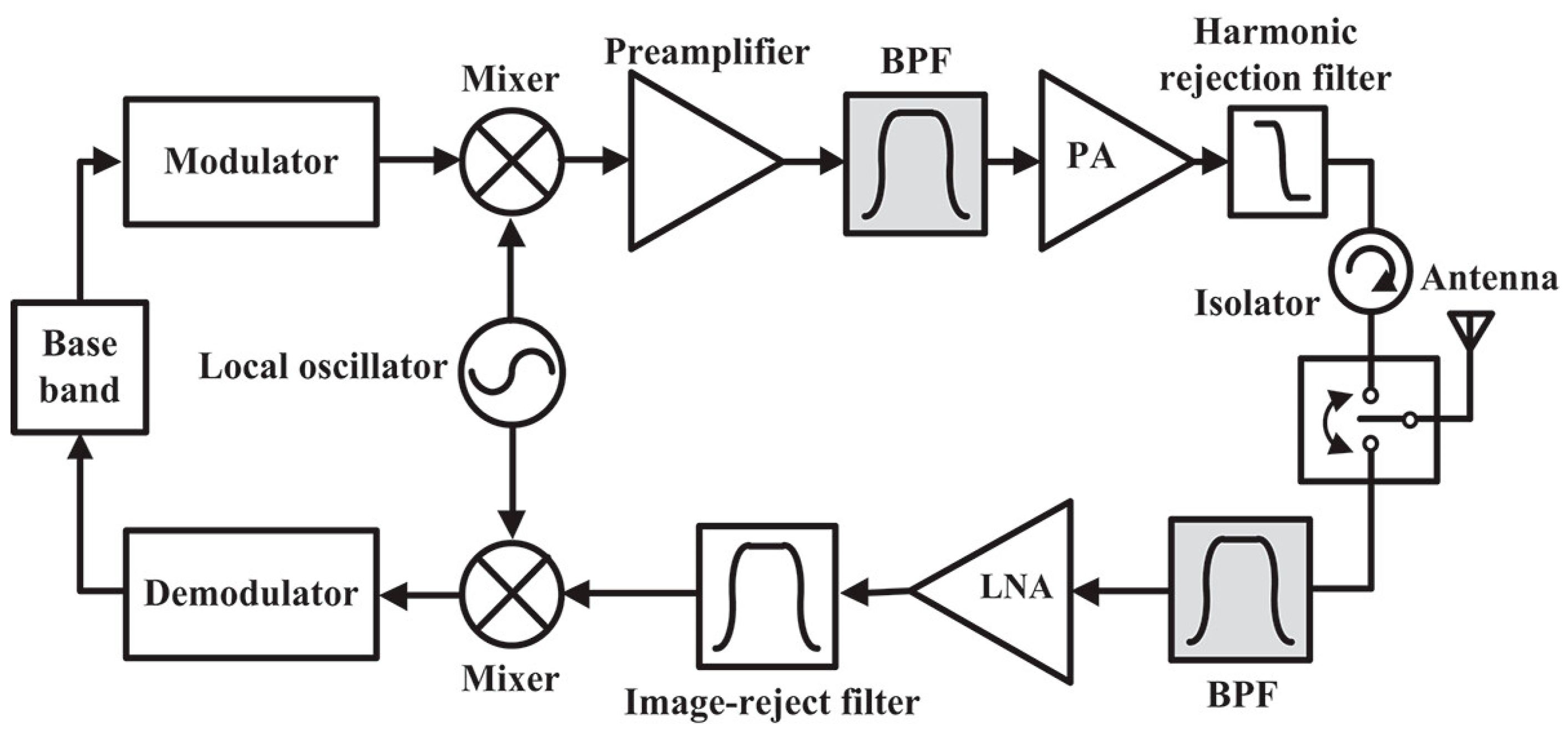

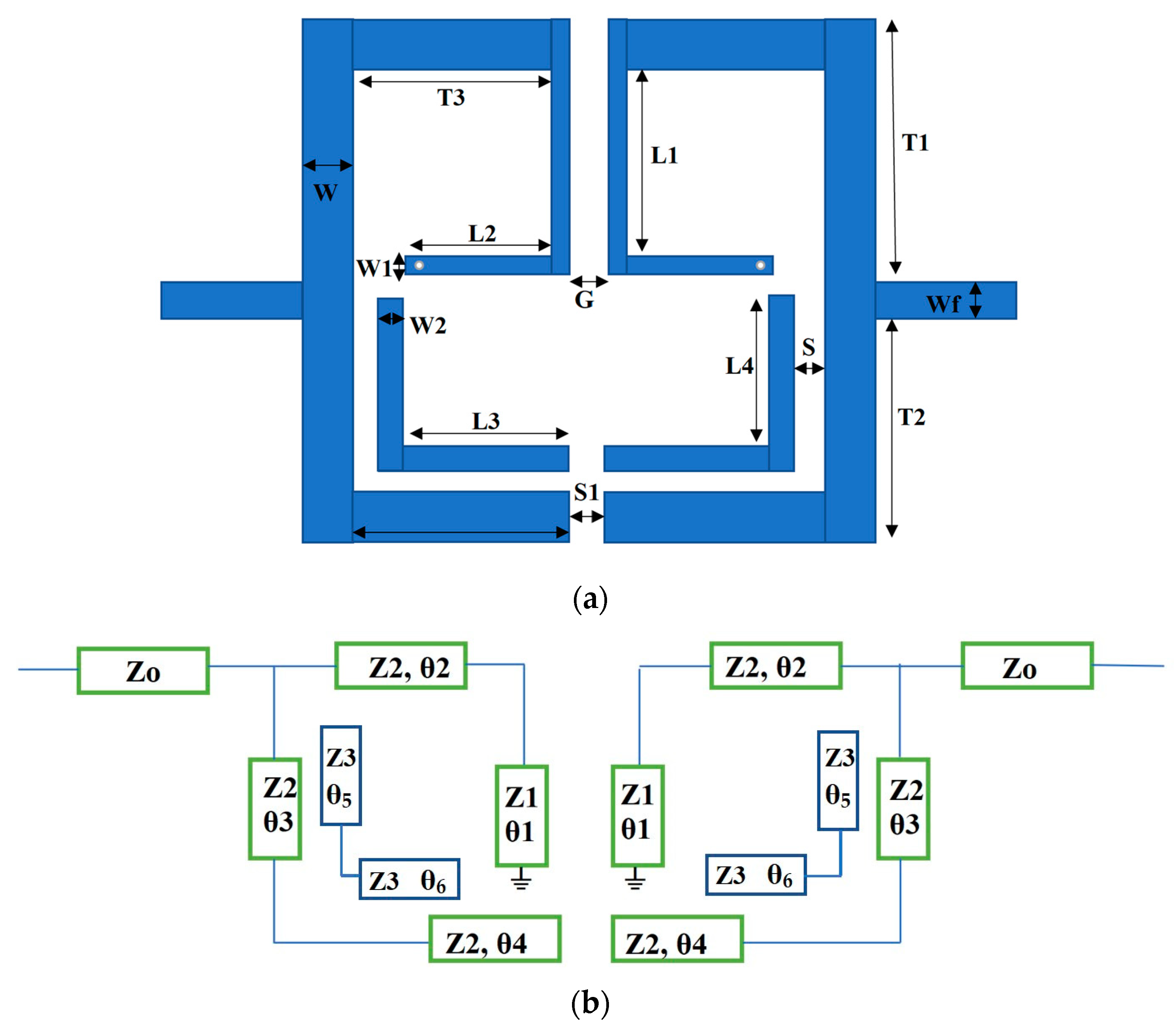


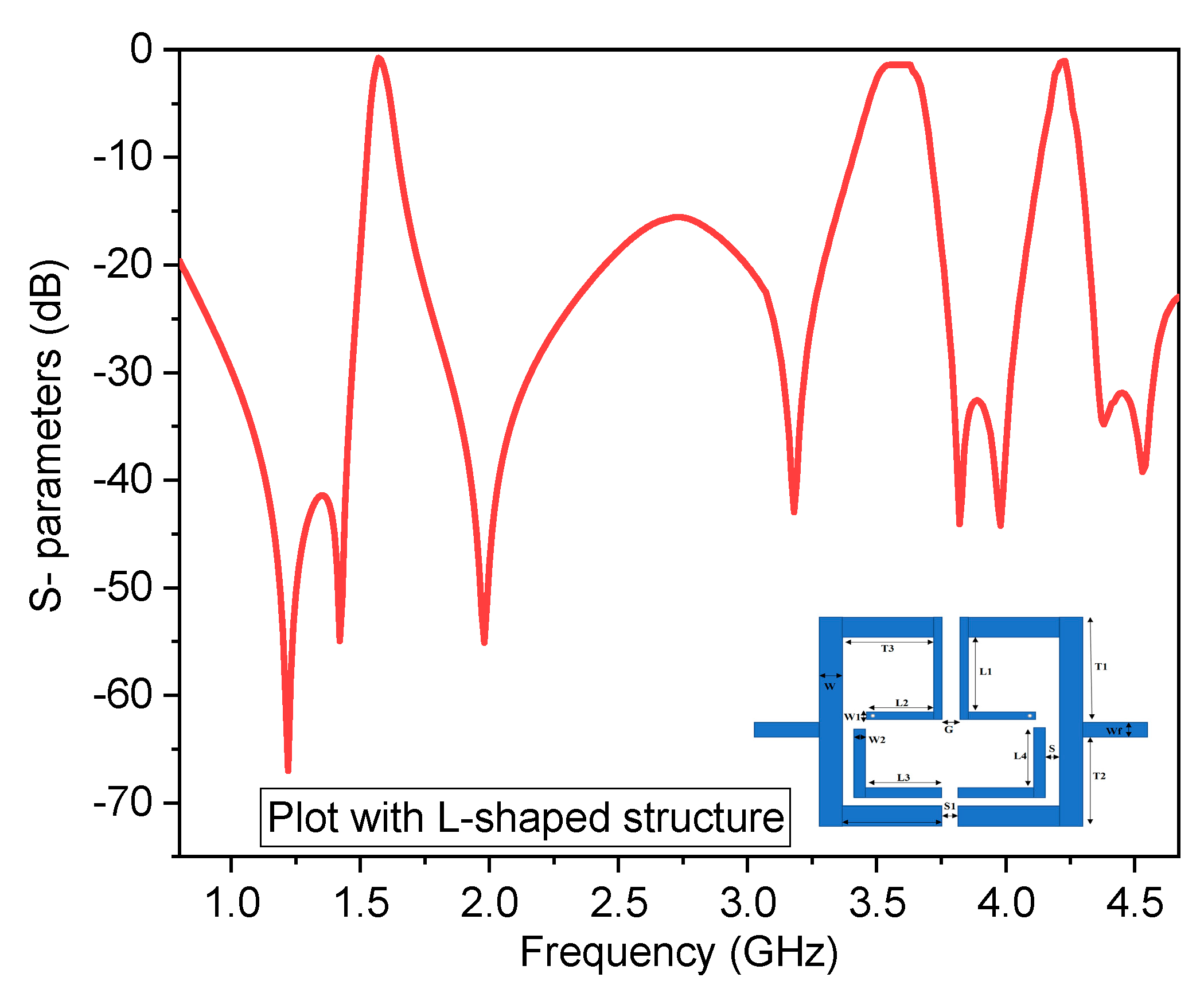
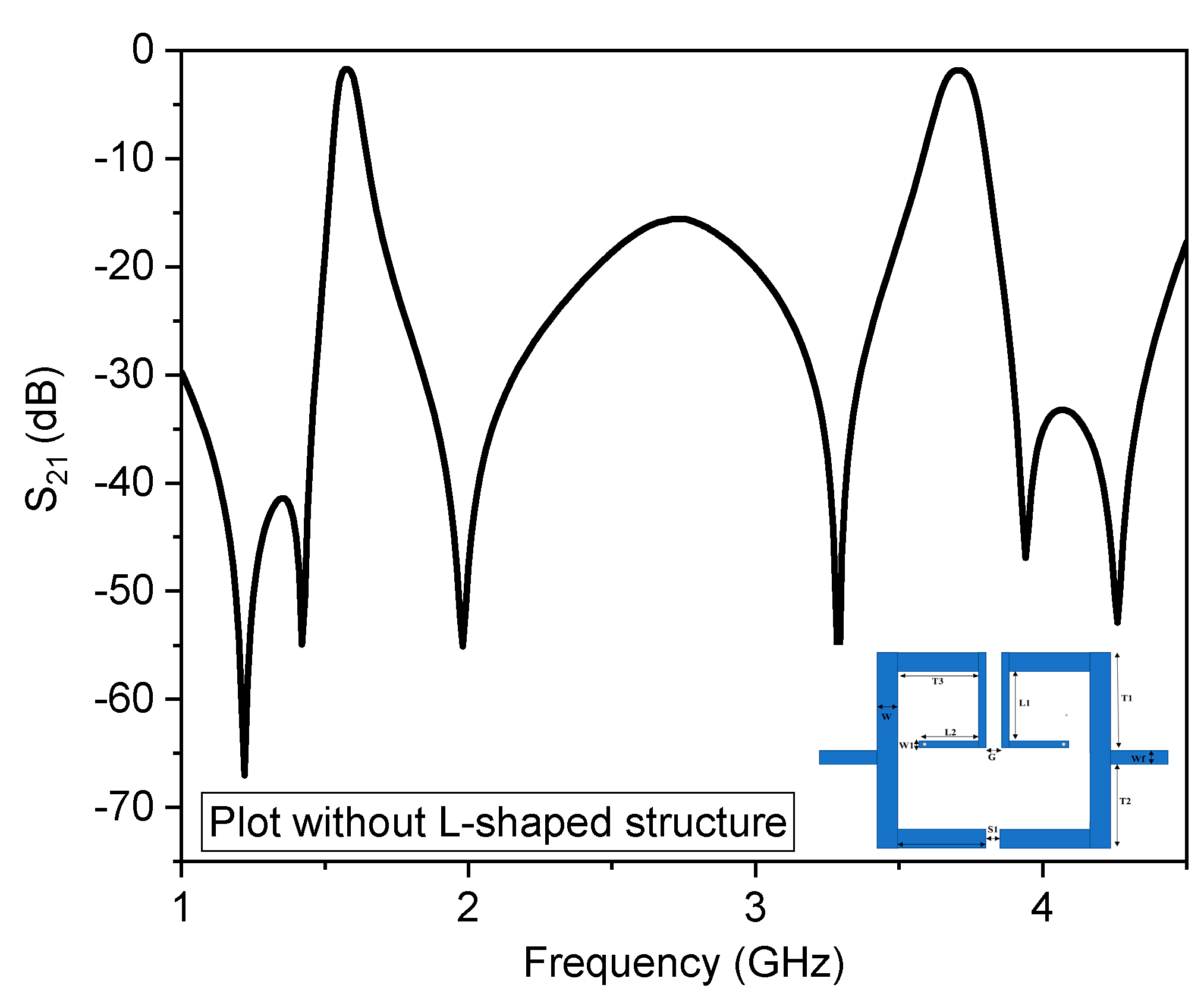


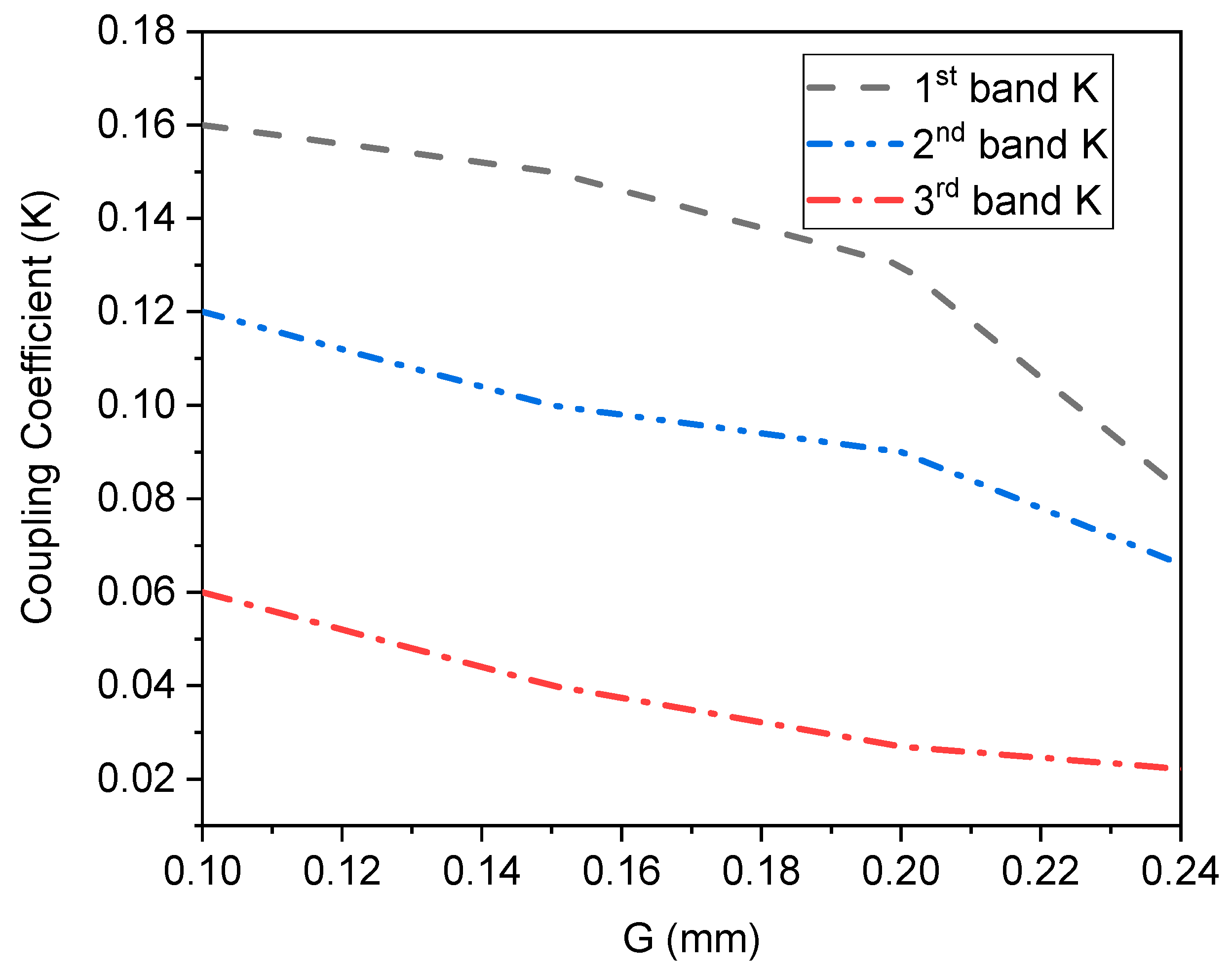
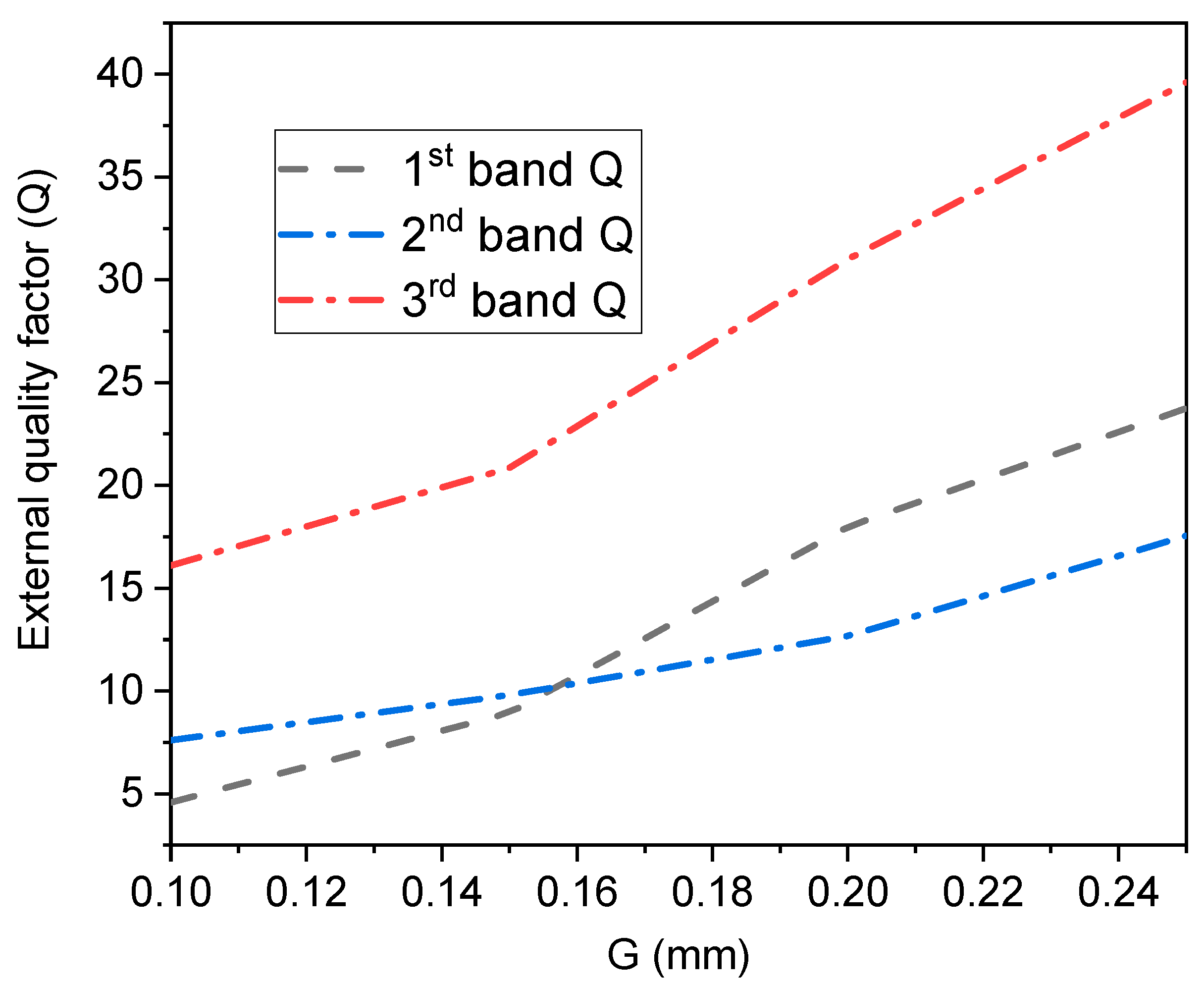
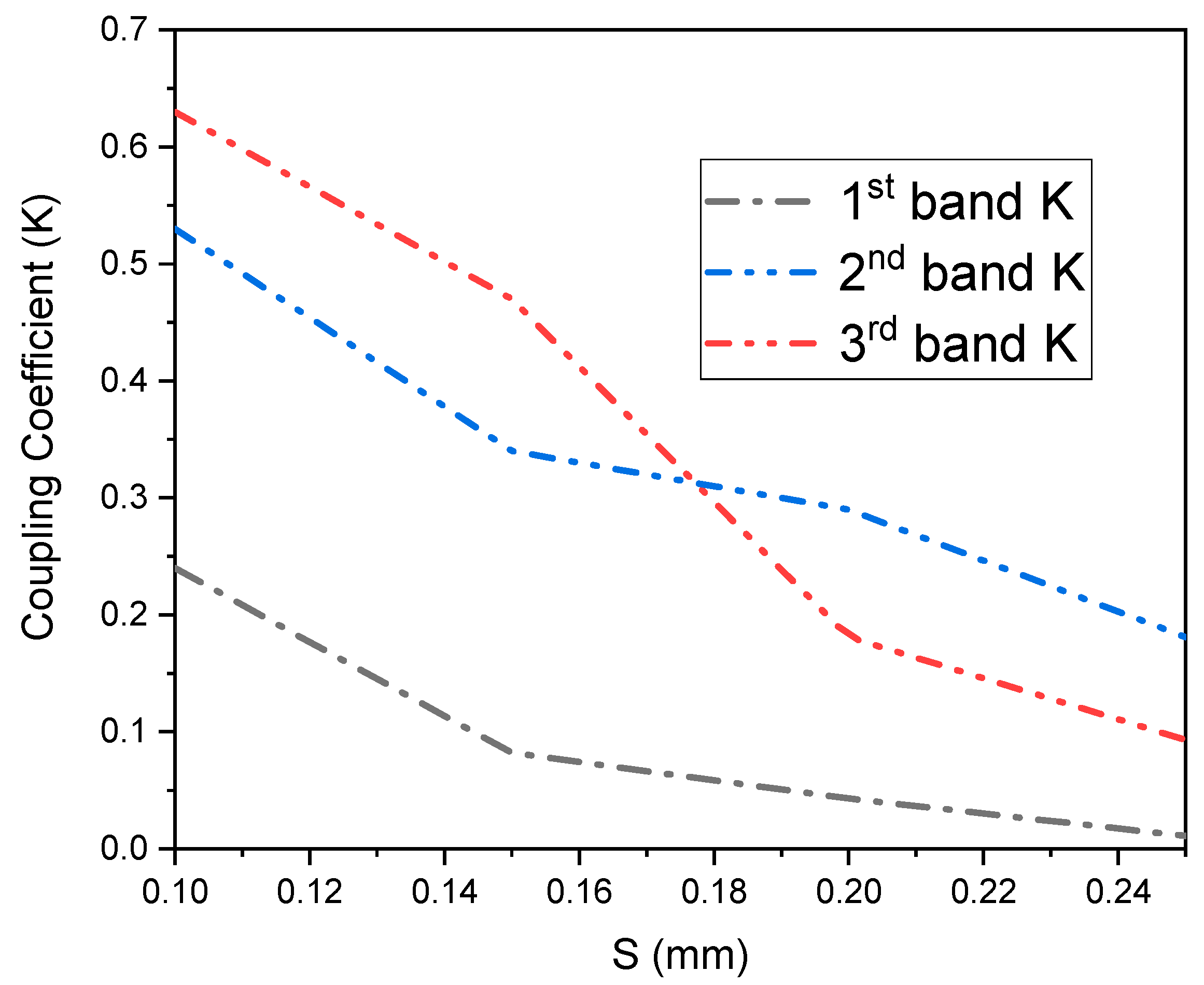
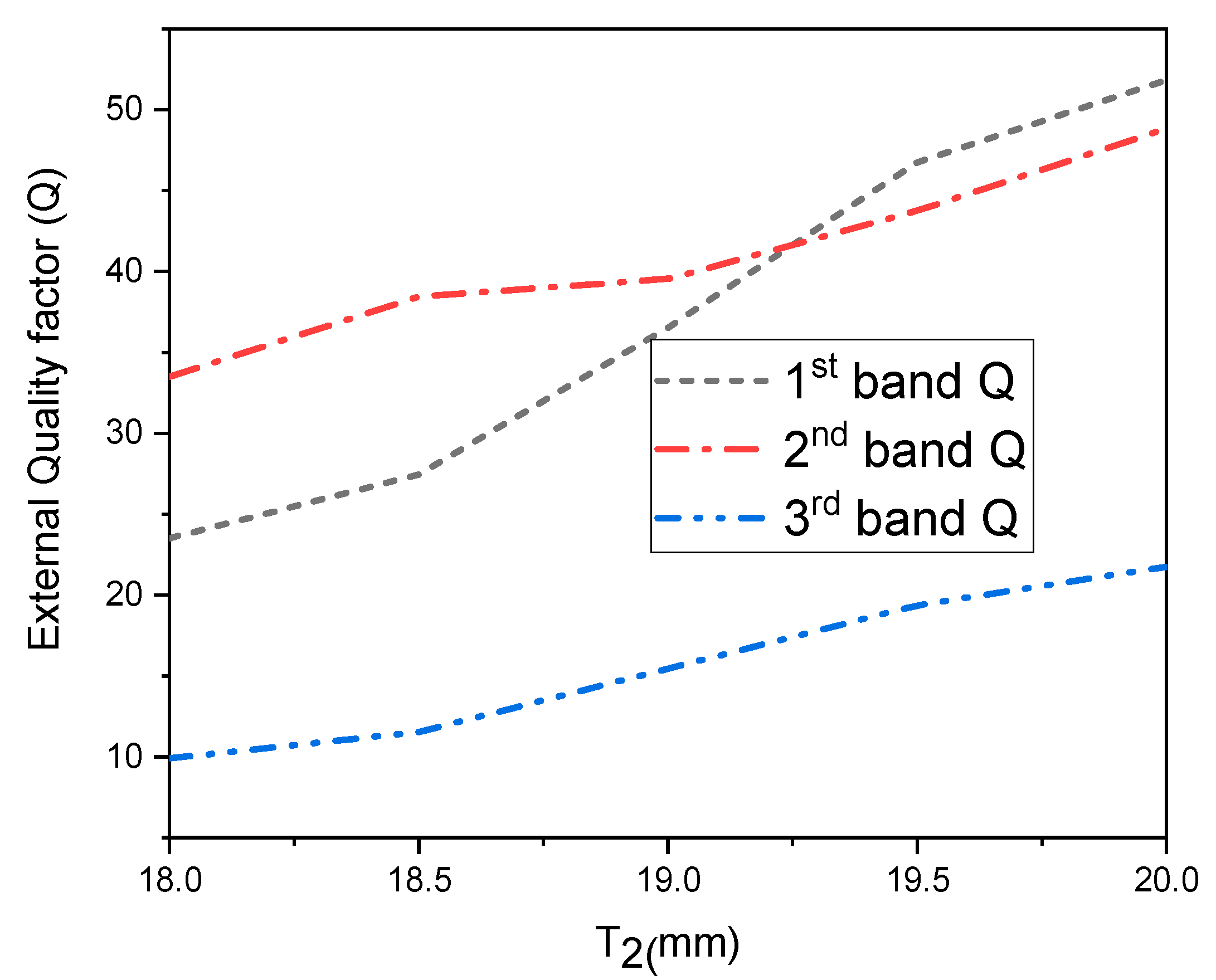
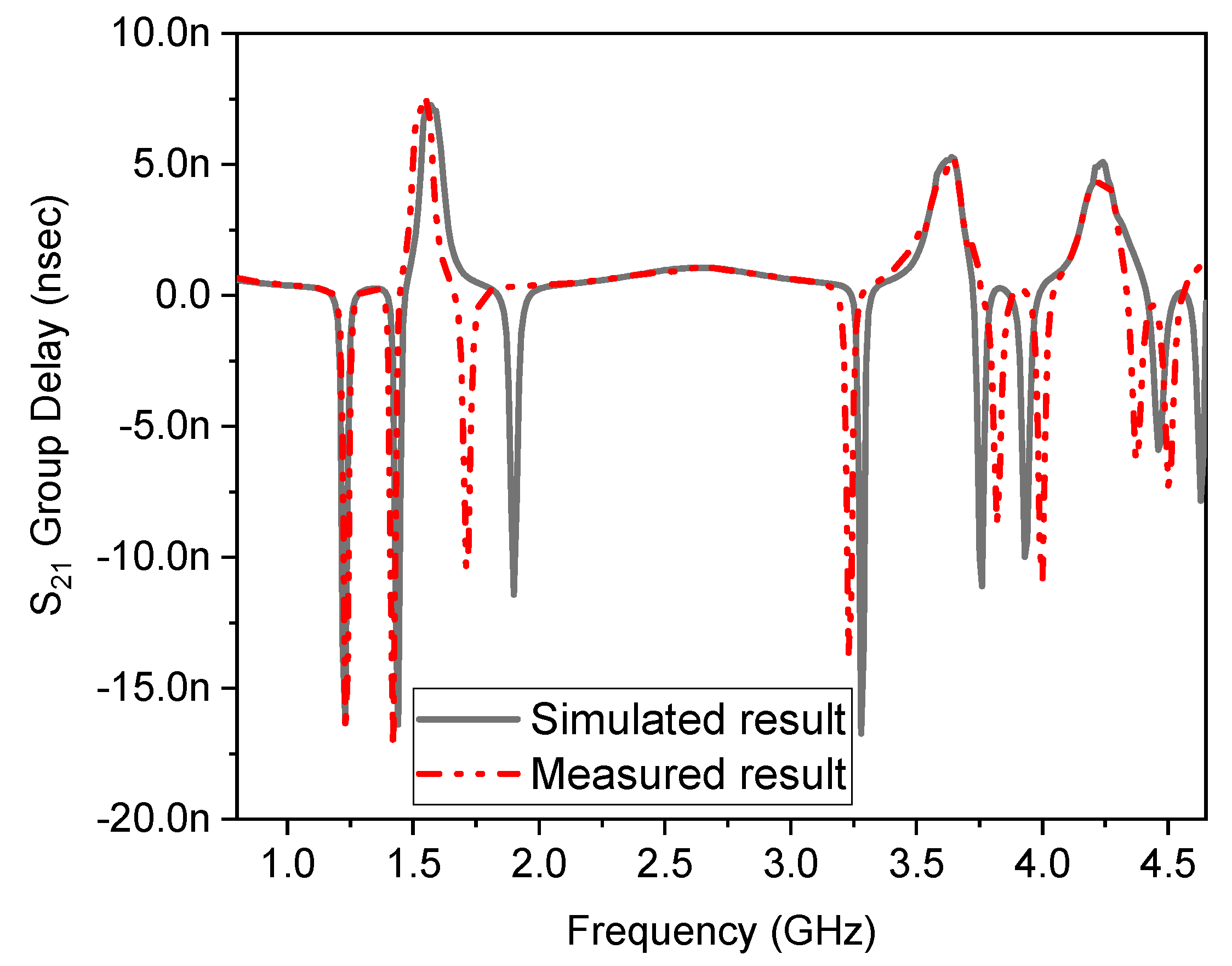
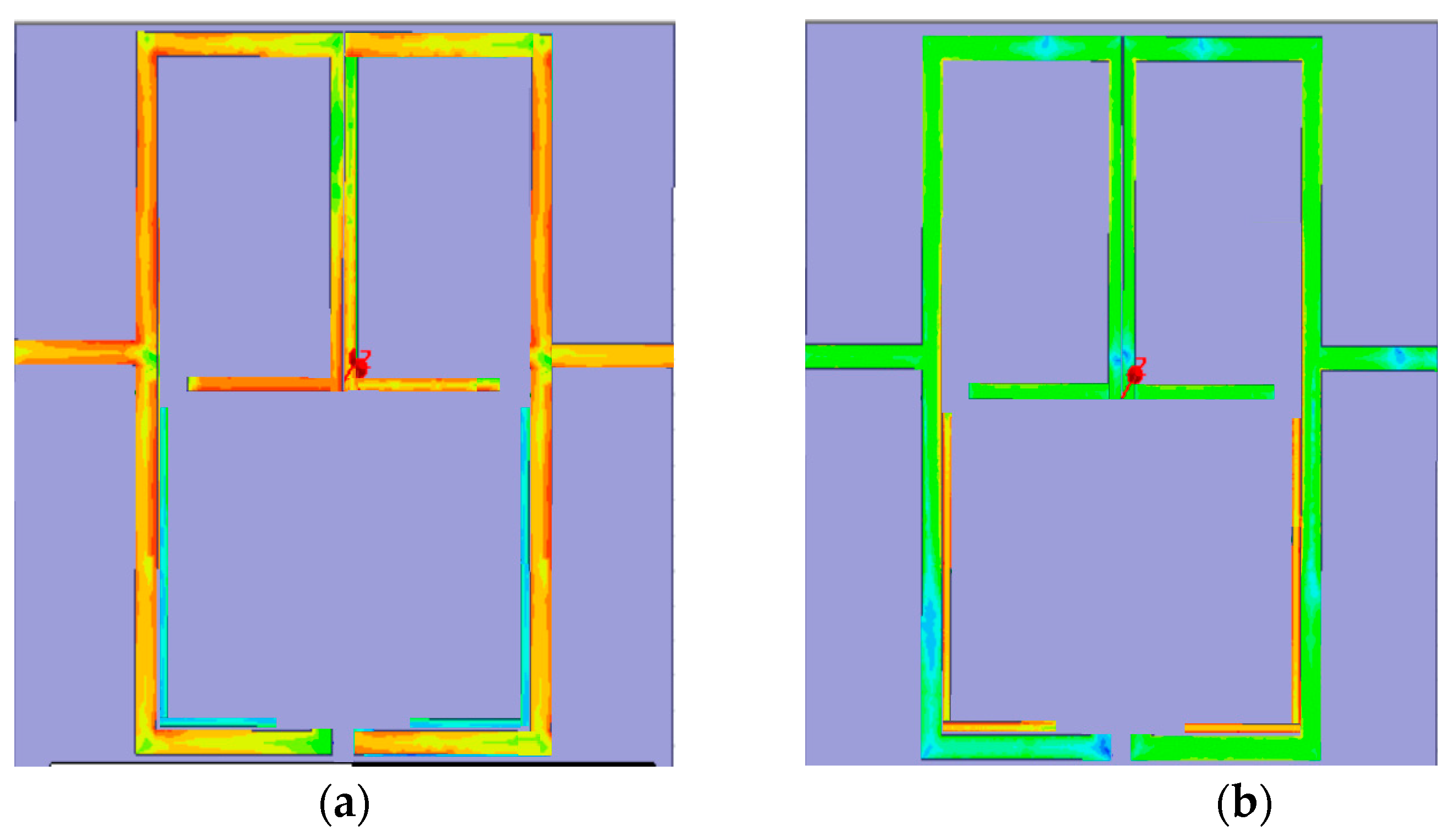
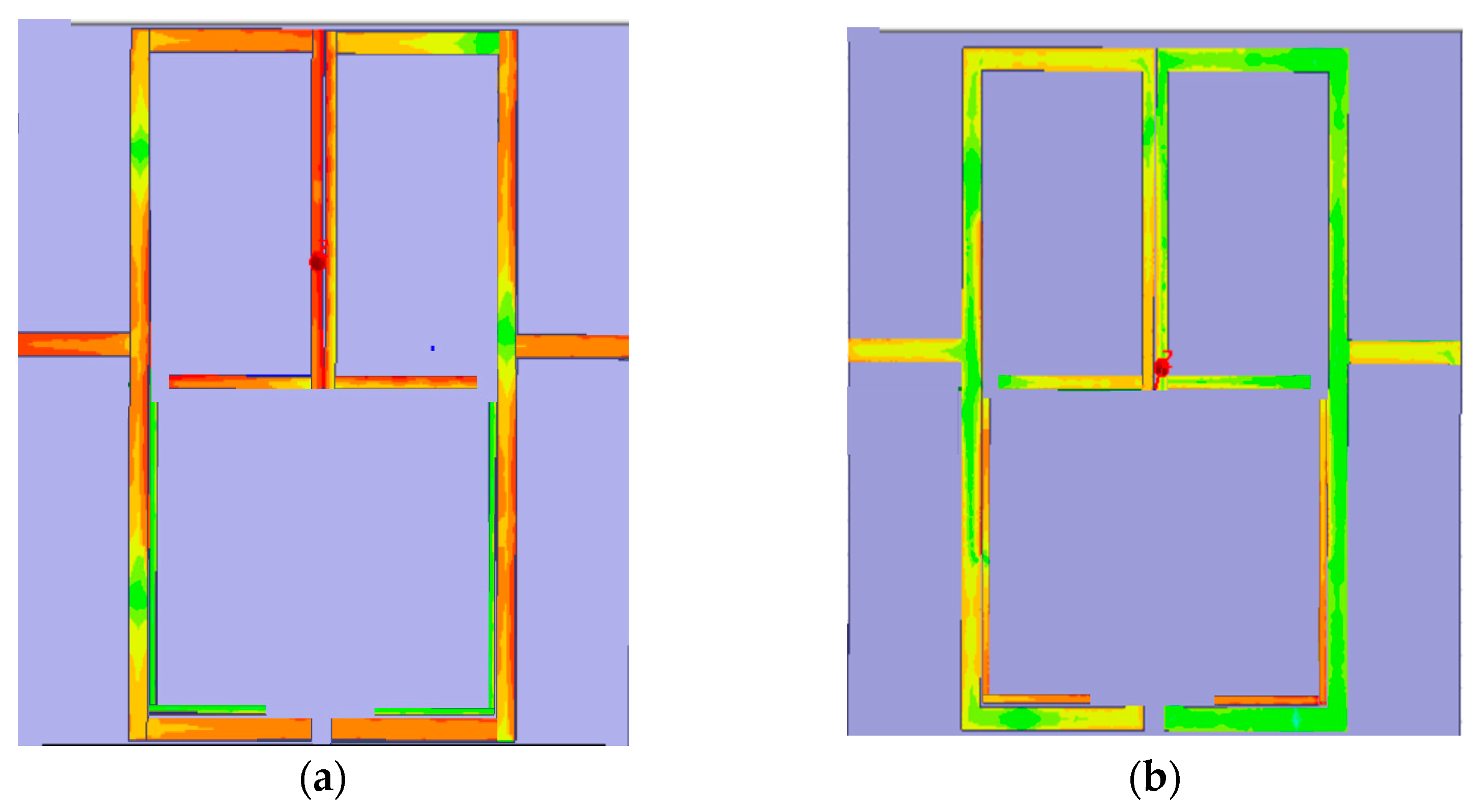

| T1 | 17.61 | T2 | 20.88 | L1 | 20 |
|---|---|---|---|---|---|
| L2 | 9.5 | W | 1.35 | W1 | 0.8 |
| W2 | 0.5 | L3 | 6.6 | L4 | 15 |
| Wf | 1.6 | S | 0.1 | S1 | 1 |
| G | 0.2 | PCB Height | 0.762 | εr | 3.66 |
| Ref No. | Year | Bands (GHz) | S21 (dB) | S11 (dB) | FBW (%) | T.Z.s | Size (mm) | Size (λg2) |
|---|---|---|---|---|---|---|---|---|
| [39] | 2020 | 2.9/5.6/11 | 3/3.1/5 | >20 | 46/18/6 | 3 | 144 × 40 | 1.864 |
| [40] | 2021 | 2.4/3.5/5.25 | <1.7 | 50/33/43 | 11.6/4/6.7 | 3 | 41 × 29.5 | 0.291 |
| [41] | 2020 | 1.93/2.6/3.9 | 1.5/0.6/1.8 | 15/20/20 | 5/11/3 | 5 | 17.2 × 24.5 | 0.415 |
| [51] | 2022 | 3.2/3.4/3.7 | 2.65/1.95/2.69 | 18.3/17.9/19.2 | 3.57/3.77/2.07 | 5 | 75 × 51.5 | 0.469 |
| [52] | 2019 | 2.45/3.5/5.25 | 0.7/0.9/0.6 | 38/32/25 | 1.2/2/1.52 | 6 | 42 × 31.5 | 0.240 |
| [53] | 2018 | 0.4/0.8/1.55 | 0.7/1.8/1.6 | 10/8.2/9.3 | 55.4/20.9/10.3 | 5 | 56 × 31 | 1.72 |
| [54] | 2021 | 2.05/2.55/3.1 | 1.98/2.17/2.01 | 12.3/14.9/14.1 | 4.8/7.8/8 | 3 | 72.1 × 68.5 | 1.931 |
| [55] | 2022 | 4.1/6.1/14.4 | 2.1/1.3/4.08 | 19.63/22/12.1 | 5.3/8.6/2.1 | 2 | 22.42 × 7.62 | 0.094 |
| [56] | 2021 | 6.28/13/19.12 | 1.6/2.5/2.2 | 22/26/21 | 9.5/6.2/4.5 | 4 | 8.5 × 15 | 0.119 |
| [57] | 2022 | 4.2/7.36/9.35 | 1.38/4.86/1.27 | 15.7/17/ 38 | 5.21/3.19/9.3 | 4 | 22 × 18 | 0.803 |
| [58] | 2020 | 1.52/2.0/2.36 | 5.32/4.2/6.8 | 15.4/19.1/17.3 | 3.56/8.6/2.75 | 5 | 54.9 × 28.6 | 0.248 |
| [59] | 2022 | 18.2/18.7/19.1 | 2.59/2.21/2.5 | 15.9/20.9/24.8 | 0.45/1.08/0.5 | 6 | 1.1 × 1.1 × 1.2 | 1.469 |
| [60] | 2022 | 3.6/4.6/5.6 | <0.78 | >30 | 11.9/11.9/11.9 | 5 | 54.34 × 22.3 | 0.911 |
| This work | 2023 | 1.57/3.57/4.23 | 0.7/1.2/1.06 | 27/35/28 | 2.54/4.2/1.65 | 8 | 40.1 × 22 | 0.086 |
Disclaimer/Publisher’s Note: The statements, opinions and data contained in all publications are solely those of the individual author(s) and contributor(s) and not of MDPI and/or the editor(s). MDPI and/or the editor(s) disclaim responsibility for any injury to people or property resulting from any ideas, methods, instructions or products referred to in the content. |
© 2023 by the authors. Licensee MDPI, Basel, Switzerland. This article is an open access article distributed under the terms and conditions of the Creative Commons Attribution (CC BY) license (https://creativecommons.org/licenses/by/4.0/).
Share and Cite
Basit, A.; Daraz, A.; Khan, M.I.; Zubir, F.; A. AlQahtani, S.; Zhang, G. Design and Modelling of a Compact Triband Passband Filter for GPS, WiMAX, and Satellite Applications with Multiple Transmission Zero’s. Fractal Fract. 2023, 7, 511. https://doi.org/10.3390/fractalfract7070511
Basit A, Daraz A, Khan MI, Zubir F, A. AlQahtani S, Zhang G. Design and Modelling of a Compact Triband Passband Filter for GPS, WiMAX, and Satellite Applications with Multiple Transmission Zero’s. Fractal and Fractional. 2023; 7(7):511. https://doi.org/10.3390/fractalfract7070511
Chicago/Turabian StyleBasit, Abdul, Amil Daraz, Muhammad Irshad Khan, Farid Zubir, Salman A. AlQahtani, and Guoqiang Zhang. 2023. "Design and Modelling of a Compact Triband Passband Filter for GPS, WiMAX, and Satellite Applications with Multiple Transmission Zero’s" Fractal and Fractional 7, no. 7: 511. https://doi.org/10.3390/fractalfract7070511
APA StyleBasit, A., Daraz, A., Khan, M. I., Zubir, F., A. AlQahtani, S., & Zhang, G. (2023). Design and Modelling of a Compact Triband Passband Filter for GPS, WiMAX, and Satellite Applications with Multiple Transmission Zero’s. Fractal and Fractional, 7(7), 511. https://doi.org/10.3390/fractalfract7070511











